Laryngectomy is a major surgical procedure, performed to remove all or part of the larynx (voice box). It is performed to treat larynx cancer, severe trauma or damage to the larynx. After the procedure, breathing happens via an opening in the neck (termed as stoma), instead of neck and mouth.
Thailand a famous tourist destination known for its beautiful beaches is now renowned for its growing medical tourism. Treatment of Laryngectomy in Thailand is performed by some of the most experienced and skilled team of surgeons. With the increasing demand for medical tourism, Thailand is budding with medical centers. These hospitals are equipped with innovative technology like robotic surgery, world-class medical facilities, and high -end infrastructure. All these benefits are available at affordable prices making Thailand as one of the preferred destinations for medical tourism
Laryngectomy surgery in Thailand along with the quality of treatment, safety measures, and after-care took on par with some of the most common medical tourism destinations like Singapore, Turkey, India, and UAE. The cost of ear surgery along with the operation, after-care, and sightseeing are available at almost half the price when compared with the value offered in US or UK.
Treatment cost
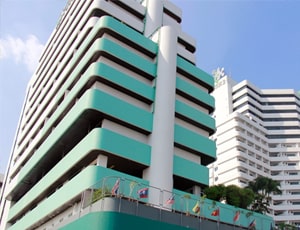
Phyathai 2 International Hospital located in Bangkok, Thailand is accredited by JCI. Also listed below are some of the most prominent infrastructural details:
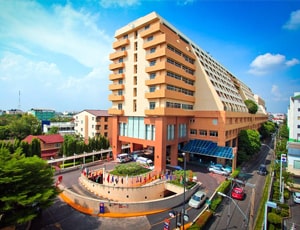
Vejthani Hospital located in Bangkok, Thailand is accredited by NABH, NABL. Also listed below are some of the most prominent infrastructural details:
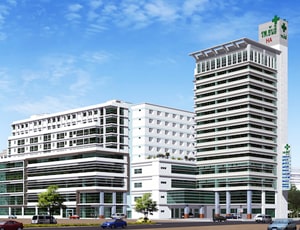
Yanhee International Hospital located in Bangkok, Thailand is accredited by JCI. Also listed below are some of the most prominent infrastructural details:

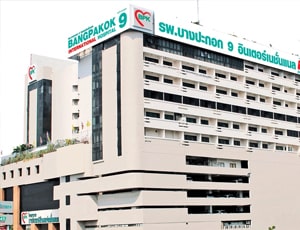
Bangpakok 9 International Hospital located in Bangkok, Thailand is accredited by JCI. Also listed below are some of the most prominent infrastructural details:
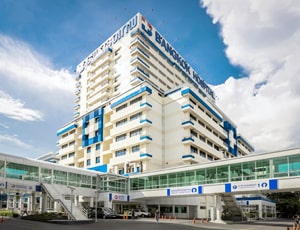
Bangkok Hospital located in Bangkok, Thailand is accredited by JCI. Also listed below are some of the most prominent infrastructural details:
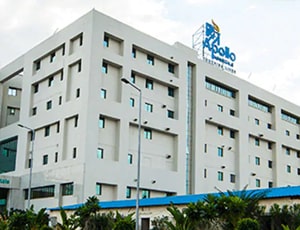
The cost for Laryngectomy ranges from USD 5120 - 5630 in Apollo Hospital
Apollo Hospital located in Chennai, India is accredited by JCI, NABH. Also listed below are some of the most prominent infrastructural details:
DOCTORS IN 13 SPECIALITIES
FACILITIES & AMENITIES
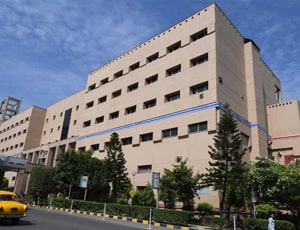
The cost for Laryngectomy ranges from USD 5170 - 5800 in Apollo Multispecialty Hospitals
Apollo Multispecialty Hospitals located in Kolkata, India is accredited by JCI, NABH. Also listed below are some of the most prominent infrastructural details:
DOCTORS IN 13 SPECIALITIES
FACILITIES & AMENITIES

Memorial Atasehir Hospital located in Istanbul, Turkey is accredited by JCI. Also listed below are some of the most prominent infrastructural details:

Medicana Bahcelievler Hospital located in Istanbul, Turkey is accredited by ISO, JCI. Also listed below are some of the most prominent infrastructural details:
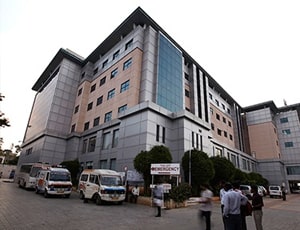
The cost for Laryngectomy ranges from USD 5150 - 5860 in BGS Gleneagles Global Hospitals
BGS Gleneagles Global Hospitals located in Bengaluru, India is accredited by NABH, NABL. Also listed below are some of the most prominent infrastructural details:
DOCTORS IN 14 SPECIALITIES
FACILITIES & AMENITIES
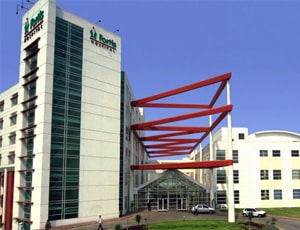
The cost for Laryngectomy ranges from USD 5130 - 5960 in Fortis Hospital
Fortis Hospital located in Noida, India is accredited by ISO, NABH. Also listed below are some of the most prominent infrastructural details:
DOCTORS IN 12 SPECIALITIES
FACILITIES & AMENITIES
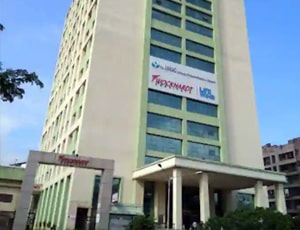
The cost for Laryngectomy ranges from USD 5200 - 5980 in Wockhardt Hospital, Umrao
Wockhardt Hospital, Umrao located in Thane, India is accredited by NABH. Also listed below are some of the most prominent infrastructural details:
DOCTORS IN 13 SPECIALITIES
FACILITIES & AMENITIES
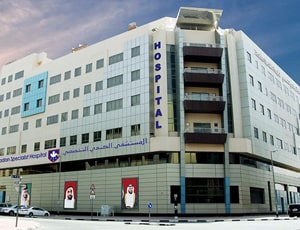
Canadian Specialist Hospital located in Dubai, United Arab Emirates is accredited by JCI. Also listed below are some of the most prominent infrastructural details:
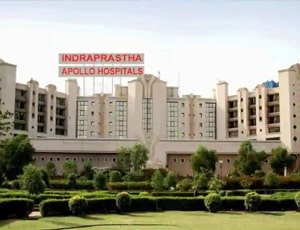
The cost for Laryngectomy ranges from USD 5360 - 6020 in Indraprastha Apollo Hospital
Indraprastha Apollo Hospital is known for delivering treatment to over 200,000 patients every year; 10,000 of which are generally medical tourists. The efficient team of doctors has the record of 99.6 percent success rate. Indraprastha Apollo Hospital deals in treatment of over 50 specialities.
Let’s see some of the features of the infrastructure:
DOCTORS IN 14 SPECIALITIES
FACILITIES & AMENITIES
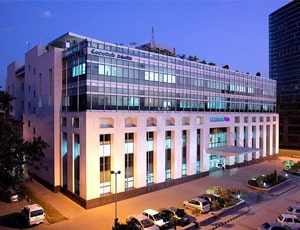
Manipal Hospital, Yeshwantpur located in Bengaluru, India is accredited by NABH. Also listed below are some of the most prominent infrastructural details:
Laryngectomy refers to the surgical procedure by which the larynx, commonly called
Laryngectomy is a serious, complex, and major surgery that requires careful monitoring and must be performed under the guidance of an experienced surgeon. This radical procedure is warranted in cases of patients suffering from:
During the laryngectomy procedure, the doctor may decide to remove entire larynx or just a part of it, depending on the extent of damage and the condition of the patient. The doctor may even decide to remove a part of the pharynx during the same procedure. A pharynx is a passage between the oesophagus and nasal cavity. The surgeon first makes a slit in the throat of the patient to expose the larynx and the surrounding tissues, which are then removed along with it. In some cancer cases, the surrounding lymph nodes are also removed.
This step is followed up with
Tracheoesophageal Puncture (TEP)
Tracheoesophageal puncture (TEP) is a special procedure, typically conducted along with laryngectomy. During this procedure, a hole is created in the oesophagus and the trachea. After the hole has healed, a prosthetic voice box is attached there so that the patient is able to speak again.
Laryngectomy is a radical procedure and it requires the patient to stay in the hospital at least for a few days after the procedure. The patient spends the initial two days after the surgery in an ICU, wherein all the vital parameters such as heart rate, breathing rate, and blood pressure are carefully monitored. The patient is unable to eat anything until the wound in the throat completely heals. The patient gets all the nutrition through a feeding tube. The neck may remain painful for many days and medications are given to manage pain and swelling.
The patients are advised to move around a bit to prevent blood clots from building up. In addition, special care is needed to prevent stoma from infection as potentially harmful viruses and bacteria can enter the body through this newly created opening in the throat. It takes a long time for the patient to adjust to the changes in their throat and neck after the removal of their voice box. In the absence of a TEP, the patients are advised to consult a counsellor who can help with non-verbal communication and oesophagal speech.
Just like any other surgery, a patient who undergoes laryngectomy is at an increased risk of suffering from
Ask your healthcare adviser for the best multiple options and choose the one that meets your expectations
The cost of Laryngectomy in Thailand may differ from one medical facility to the other. The top hospitals for Laryngectomy in Thailand covers all the expenses related to the pre-surgery investigations of the candidate. Typically, the package cost of Laryngectomy in Thailand includes the expenses related to the surgeon's fee, anesthesia, hospital, meals, nursing and ICU stay. Stay outside the package duration, post-operative complications and diagnosis of a new condition may further increase the Laryngectomy cost in Thailand.
There are many hospitals across the country that offer Laryngectomy to international patients. The following are some of the most renowned hospitals for Laryngectomy in Thailand:
While the speed of recovery may vary from patient to patient, they are still required to stay for about 21 days after discharge. This is important to ensure that the surgery was successful. During this time, control and follow-up tests take place to check for medical fitness.
There are certain expenses additional to the Laryngectomy cost that the patient may have to pay for. These are the chanrges for daily meals and hotel stay outside the hospital. The extra charges may start from USD 50 per person.
The following are some of the best cities for Laryngectomy in Thailand:
There are several doctors who are available for telemedicine consultation for patients requiring Laryngectomy in Thailand. The following are some of the best doctors for Laryngectomy in Thailand who are available for video consultation:
| Doctor | Cost | Schedule Your Appointment |
|---|---|---|
| Dr. Vitoon Leekirkgong | USD 121 | Schedule Now |
After the Laryngectomy takes place, the average duration of stay at the hospital is about 4 days. During the recovery, the patient is carefully monitored and control tests are performed to see that everything is okay. If required, physiotherapy sessions are also planned during recovery in hospital.
There are more than 5 hospitals that offer Laryngectomy in Thailand. These clinics have proper infrastructure for the treatment of patients who require kidney transplant. These hospitals comply with all the rules and regulations as dictated by the regulatory bodies and medical association in Thailand
Some of the best doctors for Laryngectomy in Thailand are: